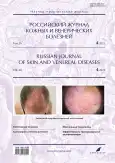Modern view on rosacea: Topical issues of epidemiology, pathogenesis and therapy. Literature review
- Authors: Aleksandrova O.A.1, Dubenskiy V.V.1, Muraveva E.S.1, Tenyaev M.A.1
-
Affiliations:
- Tver State Medical University
- Issue: Vol 26, No 4 (2023)
- Pages: 363-373
- Section: DERMATOLOGY
- URL: https://journals.rcsi.science/1560-9588/article/view/132557
- DOI: https://doi.org/10.17816/dv375277
- ID: 132557
Cite item
Abstract
Rosacea is a multifactorial dermatological disease that is widespread throughout the world, initially manifested as a cosmetic defect, and in the absence of systemic and topical therapy leads to a change in the structure and functions of the facial skin.
Patients with rosacea often seek medical attention, as these aesthetic problems impair their quality of life and contribute to the development of social and psychological problems. Chronic stress is often the cause of the development of social maladaptation, which occurs because of a constant feeling of self-doubt, own inferiority, and anxiety. Anxiety and chronic depression can cause even minor manifestations of rosacea, as it is localized on the skin of the face. Dermatosis often manifests itself in women older than 30 years, under the influence of multiple trigger factors, has a chronic relapsing course.
Understanding the pathophysiology and the use of combined therapies can improve the effectiveness of therapy in patients with rosacea, achieve and prolong clinical remission, identify trigger factors and possible prevention. This explains the need to study rosacea not as an independent dermatosis, but as a sign of more significant disorders that can lead not only to social and aesthetic problems, but also affect the general health of the patient.
Keywords
Full Text
##article.viewOnOriginalSite##About the authors
Olga A. Aleksandrova
Tver State Medical University
Author for correspondence.
Email: olgaalexandrova@live.com
ORCID iD: 0000-0001-8281-3619
SPIN-code: 8080-0721
Assistant
Russian Federation, TverValeriy V. Dubenskiy
Tver State Medical University
Email: valerydubensky@yandex.ru
ORCID iD: 0000-0002-1671-461X
SPIN-code: 3577-7335
MD, Dr. Sci. (Med.), Professor
Russian Federation, TverEkaterina S. Muraveva
Tver State Medical University
Email: katerisha87@yandex.ru
ORCID iD: 0000-0001-5326-4876
SPIN-code: 3332-8424
Assistant
Russian Federation, TverMaksim A. Tenyaev
Tver State Medical University
Email: maksonten@yandex.ru
ORCID iD: 0009-0009-4963-3814
Student
Russian Federation, TverReferences
- Olisova OY, Kochergin NG, Smirnova EA. Innovations in external therapy of rosacea. Russ J Skin Venereal Dis. 2017;20(5):270–274. (In Russ). doi: 10.18821/1560-9588-2017-20-5-270-274
- Gorbakova EV, Masyukova SA, Ilyina IV, et al. Pathophysiology of inflammation and directions of therapy for rosacea. Bulletin Med Institute Continuing Education. 2022;(3):44–47. (In Russ). doi: 10.46393/27821714-2022-3-44
- Kubanova AA, Makhakova YB. Rosacea: Prevalence, pathogenesis, features of clinical manifestations. Bulletin Dermatol Venereol. 2015;(3):36–45. (In Russ).
- Evseeva AL, Ryabova VV, Koshkin SV. Clinical case of papulopustular rosacea. Bulletin Dermatol Venereol. 2021;97(3):73–79. (In Russ). doi: 10.25208/vdv1228
- Chang AL, Raber I, Xu J, et al. Assessment of the genetic basis of rosacea by genome-wide association study. J Invest Dermatol. 2015;135(6):1548–1555. doi: 10.1038/jid.2015.53
- Two AM, Del Rosso JQ. Kallikrein 5-mediated inflammation in rosacea: Clinically relevant correlations with acute and chronic manifestations in rosacea and how individual treatments may provide therapeutic benefit. J Clin Aesthet Dermatol. 2014;7(1):20–25.
- Yamasaki K, Kanada K, Macleod DT, et al. TLR2 expression is increased in rosacea and stimulates enhanced serine protease production by keratinocytes. J Invest Dermatol. 2011; 131(3):688–697. doi: 10.1038/ jid.2010.351
- Sulk M, Seeliger S, Aubert J, et al. Distribution and expression of nonneuronal transient receptor potential (TRPV) ion channels in rosacea. J Invest Dermatol. 2012;132(4):1253–1262. doi: 10.1038/jid.2011.424
- Gerber PA, Buhren BA, Steinhoff M, Homey B. Rosacea: The cytokine and chemokine network. J Investig Dermatol Symp Proc. 2011;15(1):407. doi: 10.1038/jidsymp.2011.9
- Ryabova VV, Koshkin SV, Chermnykh TV. Rosacea. Seborrhea. Acne. Illustrated textbook for doctors. Kirov: Kirovskaya gosudarstvennaya meditsinskaya akademiya; 2011. Р. 103–106. (In Russ).
- Adaskevich VP. Classical subtypes of rosacea and rare clinical forms: Features of patient management. Smolensk Medical Almanac. 2020;(4):150–151. (In Russ). doi: 10.37963/ SMA.2020.4.150
- Mikhneva EN. Treatment of rosacea. Dermatol Venereol. 2012;(4):90–95. (In Russ).
- Butov YS. Dermatovenerology. National leadership. Short edition. Ed. by Yu.S. Butov, Yu.K. Skripkin, O.L. Ivanov. Moscow: GEOTAR-Media; 2020. Р. 668–680. (In Russ).
- Chauhan N, Ellis DA. Rosacea: Patophyziology and management principles. Facsial Plast Surg Clin North Am. 2013;21(l):127–136. doi: 10.1016/j.fsc.2012.11.004
- Kubanova AA, Dubenskiy VV, Dubenskiy VlV. Basic principles of treatment of skin diseases. In: Skripkin Yu.K., Butov Yu.S., Ivanov O.L., ed. Dermatovenerology. National Leadership. Moscow: GEOTAR-Media; 2011. Р. 197–207. (In Russ).
- Mimov AV. Combined use of pulsed laser radiation and ultrasound exposure in the treatment of rosacea patients. Bulletin New Med Technol. 2013;(1):1–3. (In Russ).
- Kubanova AA, Makhakova YB. Rosacea: Diagnosis and treatment. Bulletin Dermatol Venereol. 2015;(4):27–35. (In Russ).
Supplementary files













